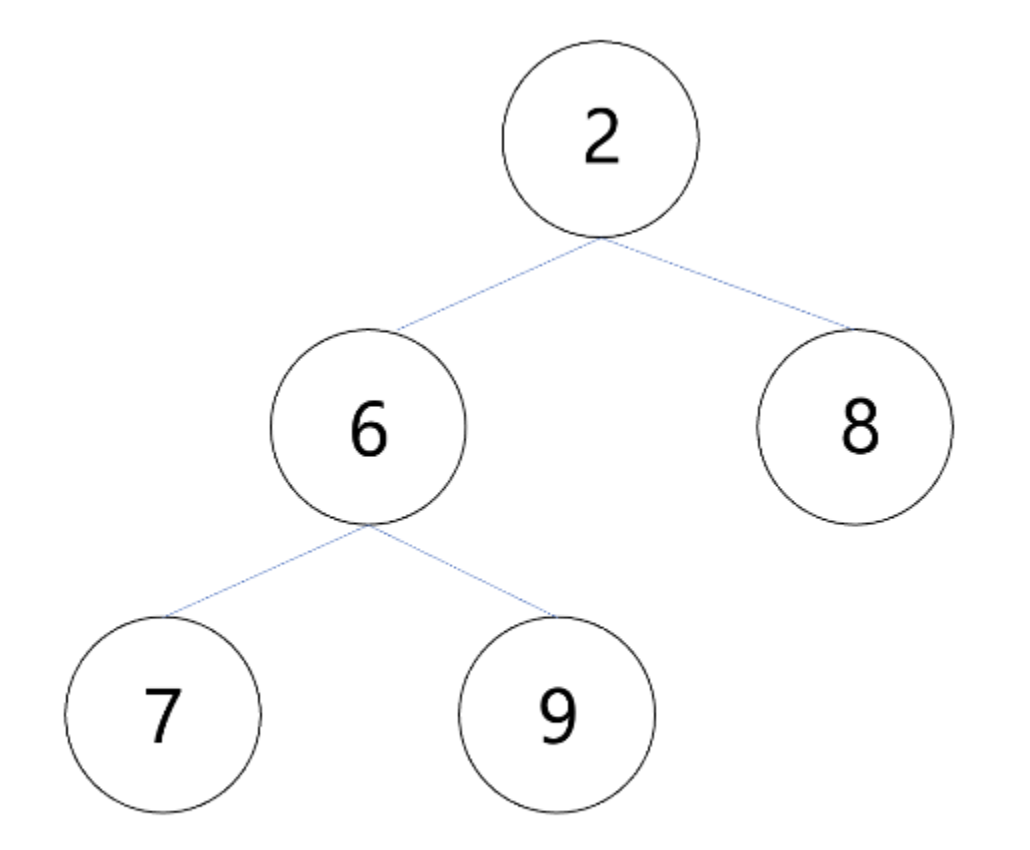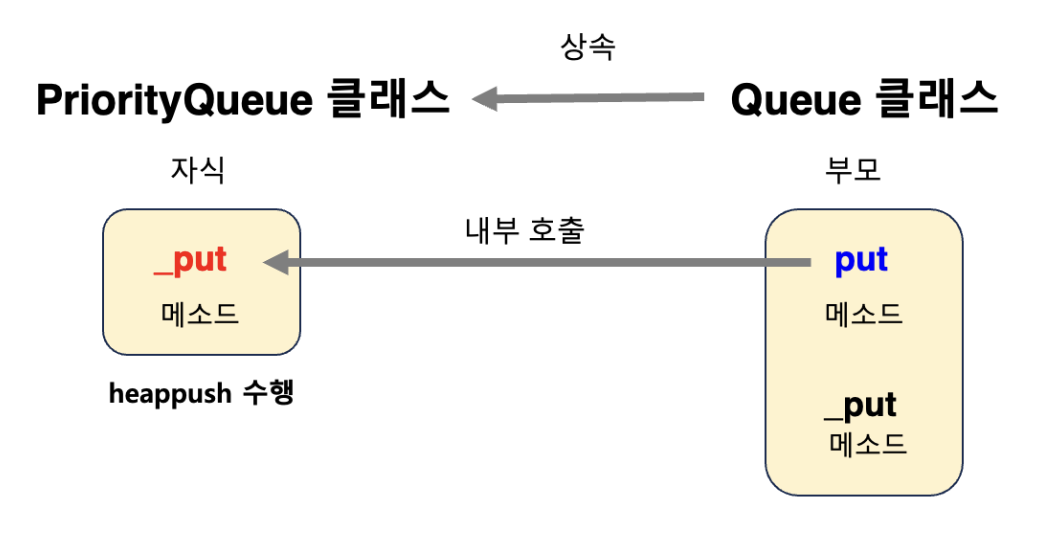[python] 우선순위 큐 PriorityQueue VS heapq
⭐️ 1. 우선순위 큐?
우선순위가 높은 데이터가 먼저 나가는 (제일 위에 놓임) 큐
즉, 제일 첫번째 원소가 제일 우선순위가 높은 것
구현 방식
- Heap, List, ... 등 구현 방식이 있다.
시간복잡도에 차이가 존재한다.
List의 경우
삽입: O(1), 삭제: O(N)
Heap의 경우
삽입: O(logN), 삭제:O(logN)
✅ 사용 예시
- 스케줄링, 사건 시뮬레이션, 우선순위에 따른 검색, 정렬 등
✅ 규칙 (최소 힙 기준)
- 부모가 두 자식보다 더 작은 수임이 보장된다. (부모가 min)
- 완전 이진 트리를 만족한다.

✅ 동작 (회소 힙 기준)
추가 (push) 동작
- 맨 마지막 원소로 추가한다
- 해당 위치에서 root까지 순회하며, min heap을 만족하는지 체크한다
시간복잡도: O(logN)

삭제 (pop)
- 맨 앞 원소를 삭제한다
- 빈 맨 앞 원소를 '제일 마지막 원소'로 채워준다 (마지막 노드 삭제)
- 새로운 root부터 시작하여, 재귀적으로 두 자식과 비교하여 min 값을 자신과 교체함
시간복잡도: O(logN)

⭐️ 2. PriorityQueue
- 파이썬의 우선순위 큐 구현체 (모듈)
- 이진 트리 형태
- 최소 힙
- 부모 노드 값 <= 자식 노드의 값
✅ PriorityQueue생성 (instance)
from queue import PriorityQueue
pq = PriorityQueue()
- PriorityQueue 클래스 instance 사용
그럼 pq에 원소를 집어넣고, .. 하기 위해
PriorityQueue class의 method를 보자!
✅ 주요 메소드 (PriorityQueue) - 직접 호출 X
def _put(self, item):
heappush(self.queue, item)def _get(self):
return heappop(self.queue)- 원소 추가: pq._put()
- 원소 삭제: pq._get()

✅ 주요 메소드 (호출 흐름)
🙋♀️ PriorityQueue의 _put을 부르면 되겠구나?
그런데,
_put 메소드는 private method 이므로 (method 앞에 _ 붙으면 private method)
pq._put() 으로 바로 호출할 수 없다 !
(사실 부를 수 있긴 하다)
🙋♀️ PriorityQueue의 부모인 Queue Class의 put을 부르면 되겠구나?
맞다!
PriorityQueue의 부모 클래스의 메소드도 사용 가능하므로,
Queue의 put을 부르면 된다.
🙋♀️ 그럼 heapify는 언제 되는거지?
Queue class의 put 메소드를 살펴보자.
put 함수 내부에서 _put 매소드를 부른다.
이때 Queue에도, PriorityQueue에도 둘 다 _put 메소드가 존재한다.
이때 메소드 오버라이딩에 의해,
PriorityQueue의 _put 이 우선순위가 더 높기 때문에,
PriorityQueue의 _put이 불리게 된다!
PriorityQueue의 _put에서는 heappush 동작이 수행된다.
즉, 이때 heapify가 진행된다
✅ 결론 1. put 쓰자 (써도 heapify 잘 된다)


✅ 결론 2. (내부구현) heappush, heappop을 호출한다
PriorityQueue 클래스 메소드를 살펴보자.
from heapq import heappush, heappop
class PriorityQueue(Queue):
# ... (중략)
def _put(self, item):
heappush(self.queue, item)
def _get(self):
return heappop(self.queue)
굳이 Queue의 put을 거치는 이유?
Queue의 put이 thread-safe 하다.
Queue에서는 init 시, 이런 mutex lock을 정의한다.
self.not_full = threading.Condition(self.mutex)
그리고 Queue의 put 메소드는,
lock을 얻은 상태에서만 실행된다.
def put(self, item, block=True, timeout=None):
with self.not_full:
if self.maxsize > 0:
'''생략'''
즉, thread-safe하기 때문에 Queue의 put을 거치는 것이다.
✅ 사용 예시
from queue import PriorityQueue
pq = PriorityQueue()
# 원소 추가
pq.put(2)
pq.put(1)
pq.put(3)
# 원소 삭제
pq.get() # 1
pq.get() # 2
pq.get() # 3
pq.get() # 무한 반복에 걸림 (주의)
pq._get() # 무한 반복에 걸리진 않지만, 권장 x (private method)
⭐️ 3. heapq
- 파이썬의 우선순위 큐 구현체 (모듈)
- 이진 트리 형태
- 최소 힙
- 부모 노드 값 <= 자식 노드의 값
✅ heapq생성
import heapq
heap = []
# heapq 메소드의 인자로 heap list 넘김
위에서 본 PriorityQueue와 달리,
리스트를 heap처럼 다룬다.
heapq의 method의 인자로 리스트를 넘기는 방식으로 사용된다.
그럼 heapq의 method를 보자!
✅ 주요 메소드 (heapq)
def heappush(heap, item):
heap.append(item)
_siftdown(heap, 0, len(heap)-1)def heappop(heap):
lastelt = heap.pop() # 맨 마지막 원소 pop
if heap:
# 리스트가 비어 있지 않다면 수행
returnitem = heap[0]
# 힙 구조 유지
heap[0] = lastelt
_siftup(heap, 0)
return returnitem
# 리스트가 비어 있다면 리스트의 마지막 원소 반환
return lasteltdef heapify(x):
# list를 heap으로 전환.
n = len(x)
for i in reversed(range(n//2)):
_siftup(x, i)- 원소 추가: heappush()
- 원소 삭제: heappop()
- 힙 구조 유지(list -> heap): heapify()
주의:
원소 추가, 삭제 후 heapify 함수 부를 필요 X
list를 heap으로 변경하기 위해 heapify 함수를 부름
+ heappush, heappop 함수의 인자로 사용되는 list는
heapify가 되었다 가정.
✅ 사용 예시
import heapq
# 힙 생성
heap = []
# 원소 추가
heapq.heappush(heap, 2)
heapq.heappush(heap, 1)
# 원소 삭제 (가장 작은 원소)
item = heapq.heappop(heap) # 1
# 가장 작은 원소 출력 (원소 삭제 X)
item = heap[0]
# list를 heap으로 변형
listA = [3, 1, 6]
heapq.heappush(listA, 2) # listA는 heapify가 되었다 가정하므로 정상동작 x # 3, 1, 6, 2
heapq.heapify(listA) # listA 리스트 heapify
⭐️ 4. PriorityQueue VS heapq 한 줄 정리

위에서도 다루어 보았듯,
PriorityQueue는 thread-safe 하다는 점에 차이가 있다.
⭐️ 5.기본 (min 순서대로) 사용하기
✅ PriorityQueue
from queue import PriorityQueue
pq = PriorityQueue()
# 원소 추가
pq.put(2)
pq.put(1)
pq.put(3)
# 원소 삭제
pq.get() # 1
pq.get() # 2
pq.get() # 3
✅ heapq
import heapq
# 힙 생성
heap = []
# 원소 추가
heapq.heappush(heap, 3)
heapq.heappush(heap, 1)
# 원소 삭제 (가장 작은 원소)
item = heapq.heappop(heap) # 1⭐️ 6. 역순 (max 순서대로) 사용하기
✅ PriorityQueue
from queue import PriorityQueue
pq = PriorityQueue()
# heap으로 생성할 원소들
items = [3, 1, 2]
for item in items:
pq.put(-item) # 음수로 입력
# pq: [-3, -2, -1]
# 원소 삭제 (가장 큰 원소)
for _ in range(len(heap)):
print(-pq.get()) # 3, 2, 1
✅ Heapq
import heapq
# 힙 생성
items = [3, 1, 2] # heap으로 생성할 원소들
heap = []
# 원소 추가
for item in items:
heapq.heappush(heap, -item) # 음수로 입력
# heapq: [-3, -2, -1]
# 원소 삭제 (가장 큰 원소)
for _ in range(len(heap)):
print(-heapq.heappop(heap)) # 3, 2, 1⭐️ 7. 코딩 테스트에서는 heapq를 쓰자
heapq가 PriorityQueue보다 속도가 더 빠르다.
위에서도 다루어 보았듯,
PriorityQueue는 thread-safe 하기 때문이다.
참고 자료
우선순위 큐 성능 시험에 관한 연구
python3.9 heapq.py 라이브러리
python3.9 queue.py 라이브러리
https://2jinishappy.tistory.com/102
자료구조 Heap(힙)이란? 기본 연산과 HeapSort, Heapify에 대해
Heap은 자료구조의 한 종류로써, 특정 property를 만족하는 Complete Binary Tree를 말한다 Heap의 어떤 node p에 대해, p의 parent node를 q라 하면 q의 value는 p의 value보다 작다 ❗❗ 이런 property를 만족하는 힙은
2jinishappy.tistory.com
https://dawitblog.tistory.com/160
[자료구조]우선순위 큐(Priority Queue)
정의 In computer science, a priority queue is an abstract data type similar to a regular queue or stack data structure in which each element additionally has a "priority" associated with it. In a priority queue, an element with high priority is served be
dawitblog.tistory.com